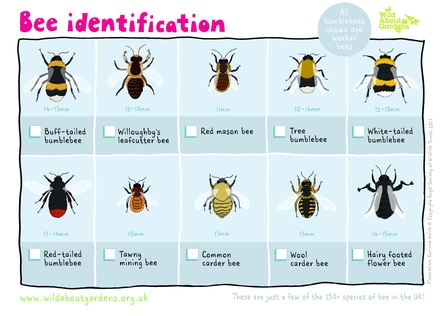Surrey Wildlife Trust’s Engagement Officer, Lizzie, and Nower Wood volunteers took on the challenge of learning all about bumblebees this year, contributing towards the Bumblebee Conservation Trust’s (BBCT) citizen science programme - BeeWalks.
Between March and October, BeeWalks take place across the country to survey 1-2km transects for bumblebees. This data is given to the BBCT to help access bumblebee population trends, along with other information such as what flowers they favour, emerging times etc. Lizzie and the volunteers, named the Bee team, created a transect at Nower Wood, Surrey Wildlife Trust’s Education Nature Reserve, to cover a wide range of habitats, including chalk grassland, ponds, heathland, glades, and woodland.
The surveys only count the bumblebees that have landed and within 2m either side, and 4m ahead for the transect route. It’s a challenge to identify fuzzy, moving objects so the team safely caught a few bumblebees to help with identification. They did this using sweep nets to catch the bees, then carefully placing the bees into small, clear pots to examine. The bees were then released soon after, so they could carry on foraging amongst the flowers.
With 24 species of bumblebee in the UK, the key to start identifying them is to look at the bottom first. It will either be red, orange or white. From there, look at the bands on the thorax and abdomen and this will narrow down what the bee is. You can also work out if you are looking at a male, queen or worker, by looking at it’s legs. Do they have a pollen basket, or a big lump of pollen on their legs? The bee is either a queen or worker. Are the hairs on the bee shaggy, and do they have a fluffier face? Then they are likely a male. There are lots more clues to working out what bumblebee you are looking at, but these are a great place to start.
It has been a survey season, with 9 surveys completed. The busiest period was July, with over 43 identified in one transect. It’s been a great opportunity to learn the common 8 species of bumblebee, who are the It has been a survey season, with 9 surveys completed. The busiest period was July, with over 43 identified in one transect. It’s been a great oplikely visitors to the flowers in your garden. The common 8 species are: Early Bumblebee, Buff-tailed Bumblebee, White-tailed Bumblebee, Red-tailed Bumblebee, Tree Bumblebee, Heath Bumblebee and Garden Bumblebee.
The Bee Team was also delighted to identify Southern Cuckoo Bees and Forest Cuckoo Bees on the BeeWalks. Cuckoo Bees are like the Cuckoo bird, where the female cuckoo bee finds their chosen species of bumblebee’s nest and either kick out, or kill, the queen. The cuckoo females then lay their own eggs, which the original worker bumblebees raising them without realising. Not much is known about cuckoo bees, so finding 2 separate species was a real highlight.
During the walks, the Bee team also noted what flowers the bumblebees were feeding on. Some of the top plant species visited by the bumblebees included Bramble, Marjoram, Heather, Thistle, Buddleia and Knapweed. Perhaps some of these could be included in your allotment or garden at home, if they are not already?



